Onychomycosis is an insidious disease, since many people do not recognize the first symptoms and turn to specialists with active progression of the disease. At this stage, it is impossible not to notice the signs, the nails begin to collapse, peel off, inflammation spreads to the skin, nearby areas become inflamed. In order to take timely action, you need to know what toenail fungus looks like.
Almost two thirds of the world's population have to deal with the manifestations of a fungal infection. Onychomycosis, or nail damage, is not just an aesthetic problem, in later stages the disease begins to cause physical discomfort.
Onychomycosis is difficult to treat, this disease is more responsive to treatment if you take action in its early stages. And for this you need to know what the nails affected by the fungus look like.
Description of the disease
A fungal disease that affects the nails is called onychomycosis. The fungus penetrates deep into the plate and destroys keratin - the base of the nail plate. Fungal spores invade the intercellular space and begin to multiply quickly.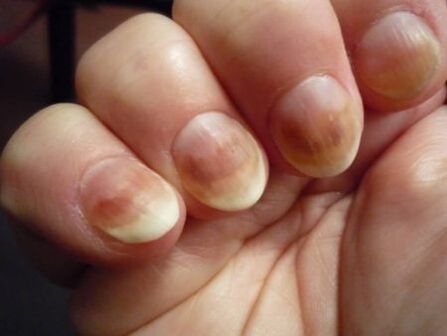 If the infection is left untreated, the disease affects the nails and spreads to nearby areas of skin without adequate therapy.
If the infection is left untreated, the disease affects the nails and spreads to nearby areas of skin without adequate therapy.
infection
Fungal spores are present in the environment. They are very resistant to external influences, spores do not die off even in freezing temperatures. Nevertheless, active reproduction of mushrooms is only possible in a warm and humid environment, so people are most at risk when visiting public baths, swimming pools and gyms.
If there is a person infected with onychomycosis among the visitors, fungal spores are left on the objects with which they have been in contact, which remain active for a long time. And these spores attack the skin and nails of healthy people. To "catch" an infection, it is enough to walk barefoot on the floor on which there are fungal spores.
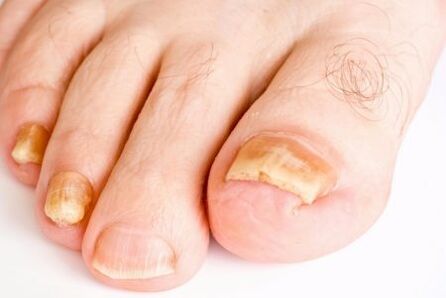
Advice! Wooden surfaces are particularly dangerous - floors, grilles in shower rooms, benches. The fact is that the tree has a porous structure, and even a thorough disinfection will not be able to destroy the spores of pathogenic microorganisms.
But of course not every "meeting" with mushrooms ends with a disease. In most cases, the body's immune system successfully fights the infection. However, when the body is weakened or the person does not observe basic hygiene measures, the chances of developing onychomycosis increase.
Factors that contribute to the development of the disease
In order for the mushroom to start its licensing activity, certain conditions must be met. Most often, the elderly are prone to the disease, they have a weakened immune system, so onychomycosis is observed more often in the elderly than in young people. Risk factors:
- Failure to comply with hygiene regulations, wearing shoes that are too tight, clothing and shoes made of synthetic materials;
- the presence of skin damage, even a small scratch, is the "gateway" for infection;
- Pathology of the endocrine system;
- chronic diseases that weaken the immune system;
- long-term use of medication, especially hormones, cytostatics, and antibiotics.
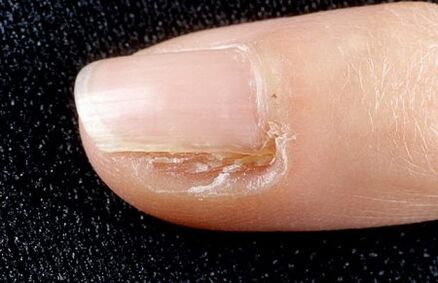
Advice! You can get onychomycosis at a beauty salon by getting a manicure or pedicure. If the master of instrument sterilization does not pay due attention, files from a cutter can become a source of infection.
Causative agent of the disease
To date, around fifty species of fungus have been identified that can cause onychomycosis. Because of this, you shouldn't self-medicate. Medicines that are effective for one type of nail fungus may be of no use if the disease is caused by another type of pathogen.
The complexity of the treatment lies in the fact that the infection is localized not on the nail surface, but under the nail plate. Therefore, the use of external drugs does not always produce the expected effect. If left untreated, the disease will progress. In addition, the more the disease begins, the more difficult it becomes to cure it.
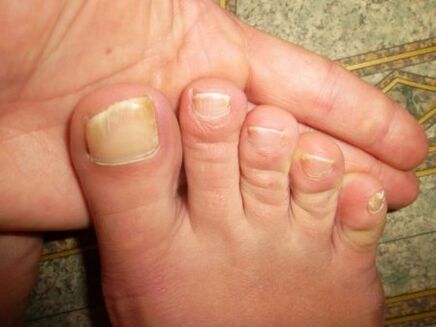
Onychomycosis often occurs on the legs. The infection can affect the nail of the first toe, but over time it can spread to other nails. Fungi on the hands are much rarer, but this disease should not be considered rare.
clinic
Symptoms depend on the shape and stage of the lesion, so it is impossible to give an unequivocal answer to the question of what the fungus looks like on the nails.
The most common case
The initial stage is called normotrophic. At this stage, the manifestations are weak, so many patients do not pay attention to them. Most often you can see the following signs:
- Loss of transparency;
- the appearance of yellowish spots, most often on the outer edge;
- sometimes one has the feeling that a "cavity" has formed between the nail and the nail bed.
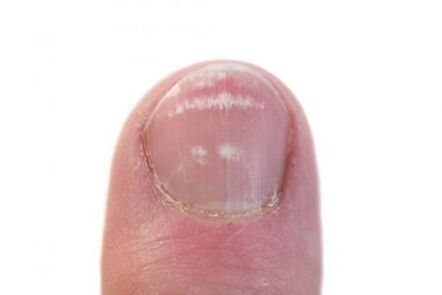
This lesion is called the distal-lateral and is the most common. If no treatment has been carried out, the process begins to progress. Subungual keratosis occurs. This phenomenon is characterized by an increased growth of horny cells, which makes the nail thicker.
Advice! Hyperkeratosis is a normal response of the nail to infection. The deeper the infection penetrates the nail plate, the thicker the nail will be.
At a later stage, complete damage to the nail plate is noted, signs of dystrophy appear. Gradually, the matrix is also included in the process - the place where the nail grows. At this stage, even removing the nail will not produce a result, since the patient's nail plate is already beginning to grow.
Surface shape
At the initial stage, whitish spots appear on the nails in this form. Over time, they grow and cover the entire surface of the nail. The plate becomes loose, rough. If you scratch the nail with a hard object, the scales will start to peel off.
Advice! This form of the fungal disease only occurs on the toes, most often on the large, less often on the little finger.
Proximal subungual
In this form, the affected nails look like this:
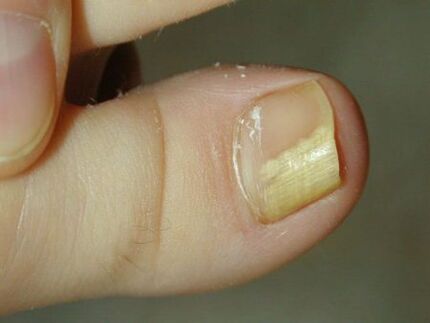
- the tissue surrounding the nail becomes red and inflamed;
- the roller swells, becomes painful;
- the cuticle begins to peel off the nail;
- dystrophic changes in the nail appear, first grooves appear on the plate, then brittleness appears, and at the advanced stage the plate disappears.
Varieties of mushrooms
The manifestations of the disease also depend on the type of pathogen. Of course, it is possible to precisely determine the type of pathogen only after testing. External signs are also different, but still the symptoms are not diagnosed:
- Dermatophyte. Fungi of the genus dermatophytes feed on keratin, which means that they "attack" hair, nails and the upper horny layer. About 40 types of fungi of this type are known, but onychomycosis only causes about a dozen types of pathogens. Source of infection is a sick person, you can get infected through direct contact or by using ordinary objects. Stripes and spots appear on the affected nails first, then the edge of the nail gradually turns yellow and gradually lags behind the nail bed. The larger the area of the stain, the higher the infestation.
- Yeasts. These are pathologies caused by fungi belonging to the genus Candida. The causative agent of this species is opportunistic. That is, in a certain amount, fungi are present on the surface of the skin and nails, but with a decrease in immunity, the fungi begin to multiply, which leads to inflammation. When the nails are damaged, the plate gradually thins, turns yellow, then turns brown, and lags behind the nail bed. With this type of infection, the nail folds are severely affected, they turn red, swell and become painful.
Advice! Usually the fungal infection develops gradually. The disease often lasts for years without advancing to an advanced stage. But when the nail plate is affected by yeast, the disease progresses very quickly.
- To shape. Mold infections are localized on the top of the plate without penetrating deep into the plate. Therefore, this type of onychomycosis is easier to treat than others. The first signs of damage are a change in the color of the nail plate. In addition, the nail acquires an unnatural color, it can turn green or black. At the initial stage, dark points appear on the nails, which gradually develop into spots, and over time the entire plate changes color.
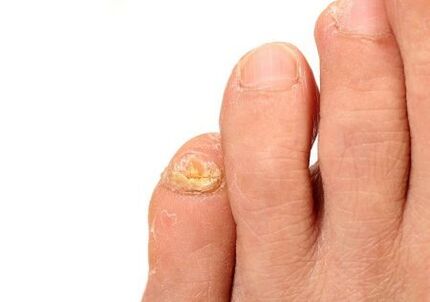
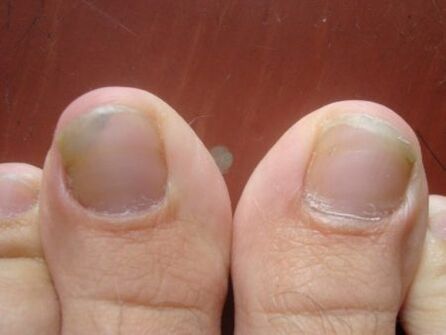
If the onychomycosis is left untreated, the pathogens spread to the skin of the feet and cause skin mycoses. In this case, symptoms such as itching, cracks in the skin appear. It becomes painful for the patient to put on shoes and walk.
What should I do?
What should you do if you notice signs of a yeast infection? Self-medication is not worth it. A dermatologist should be consulted. The specialist will prescribe tests and make an accurate diagnosis. Parents of children need to be especially careful. Of course, nail fungus is not observed too often in children, but nevertheless such a disease occurs at any age.
Remember that the earlier treatment is started, the easier it is to deal with the disease. If treatment of the fungal infection is started at an early stage, then local remedies - ointments, solutions - can be used. However, they require persistent treatment for several weeks.
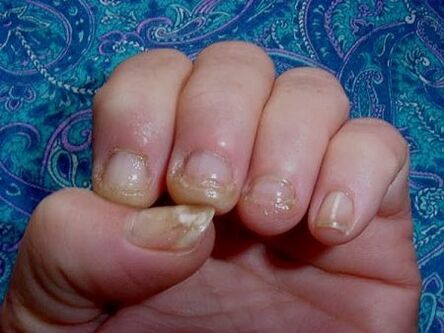
At advanced stages, it is necessary to apply not only ointments, but also drugs with a systemic effect, that is, tablets. Such drugs are taken orally from the digestive tract, active ingredients are absorbed into the bloodstream and transported through the body with the bloodstream. This destroys the infection from the inside.
At any stage of the disease, it is very useful to work on strengthening the immune system. Immunomodulators are prescribed by a specialist if necessary. And the patient alone has to set up a rest program, sleep more and walk every day. You also need to monitor your diet. The "favorite food" of mushrooms is sugar, so you need to minimize the amount of sweets in your diet.
Therefore, it is useful for everyone to know what the nail fungus looks like on their hands and toes. This knowledge will help identify signs of the disease in a timely manner and start treatment at the earliest stage. This allows you to quickly cope with the disease and avoid using systemic drugs that have a negative effect on the liver.


























